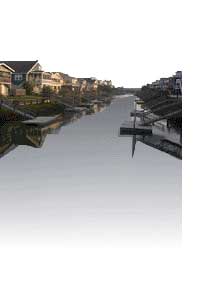 |  |  |  |
| THE WORLD WE LIVE IN |
 |
| WATER |
 |
|
|
KINGSMEADOWS RIVULET LITTER PREVENTION STRATEGIES
INLAND WATER
WATERWATCH , is a national community
waterway monitoring &
environmental education programme ,
with more than 2000 groups in the network and
over 5000 sites.
WATER FACT # 1
A gigalitre = 1000 megalitres,roughly 1000
Olympic Swimming Pools
of water.
WATER FACT # 2
National Water Week is fom October 15 - 21
WATER CONSERVATION
On average flushing the toilet flows at 12 litres
per minute.
showers 40-250 litres
baths 50 -150 litres
washing machines 40-265 litres
washing dishes by hand 18 litres
dishwasher 20-90 litres
washing the car 100-300 litres
dripping tap 200 per day
hand held hose 10-20 litres per minute
WATER WEEDS OF NATIONAL SIGNIFICANCE
include,Alligator Weed,Athel
Pine,Hymenachne,Fanwort,Mimosa &
Salvinia
Valuable & Technical information on water
management systems
can be found at:COUNCIL NET , and AUST WATER
& WASTE
WATER ASSN
STREAMWATCH - NSW
WETLANDS NEWS
World Wetlands Day for 2000 was on Wednesday
,February 2.
Wetlands can be either Coastal Wetlands,Desert
Lakes & Water
Courses,High Country Wetlands or Northern
Monsoon Floodplains.
Tasmania's significant wetlands include Moulting
Lagoon,Logan
Lagoon Conservation area,Lavinia Nature
Reserve,Pittwater-Orielton Lagoon,Apsley
Marshes,East Coast
Cape Barren Island Lagoons,Floodplain Lower
Rigarooma
River,Jock's Lagoon,Interlaken lakeside reserve
and Little
Waterhouse Lake.
THERE IS A WETLANDS STRATEGY FOR
TASMANIA DRAFT
DISCUSSION PAPER .which has as it's aim
to provide direction and guidance for
decisionmakers and
community projects to ensure that our wetlands
are
protected and properly managed in perpetuity.
Written comments were to be sent by OCTOBER
30,2000 to The
Minister,Department of Primary Industry,Water
and Environment,!st
Floor,Franklin
Square Offices,Hobart,7000
Wetlands are important:- because they purify
water and provide
flood protection through their ability to absorb
water.
:-because of their role in providing a habitat for a
diverse range of
life.
:-because of traditional Aboriginal and European
links
:-Because of their recreational opportunities
\ :- because they provide water for stock and
support wildlife
which in turn controls pests on farms
and because they are breeding grounds for many
fish which stock
commercial and recreational fisheries.
The major threats to wetlands are the human
activities occurring
in their catchments including pollution and
inappropriate urban
developments.Inappropriate vehicle use "within"
the wetland is also
a threat.
How threatened are wetlands?
It has been estimated that half the world's
original wetland areas
have been destroyed.
In Tasmania 51% of remaining wetlands have
been disturbed and
12% severely disturbed.
This degradation and loss of wetland areas has
directly impacted
on biodiversity.
|
|
Drinking Water :
This item has been contributed any medical
information should be verified with your
own doctor.
75% of Americans are chronically dehydrated.
Likely applies to half world pop.)
In 37% of Americans, the thirst mechanism
is so weak that it is often mistaken for
hunger.
Even MILD dehydration will slow down one's
metabolism as much as 3%.
One glass of water shut down midnight hunger
pangs for almost 100% of the dieters studied by U-Washington.
Lack of water, the #1 trigger of daytime fatigue.
Preliminary research indicates that 8-10 glasses
of water a day could significantly ease back and
joint pain for up to 80%of sufferers.
A mere 2% drop in body water can trigger fuzzy
short-term memory,trouble with basic maths, and
difficulty focusing on the computer screen or on
a printed page.
Drinking 5 glasses of water daily decreases the
risk of colon cancer by 45%,plus it can slash the
risk of breast cancer by 79%,and one is 50% less
likely to develop bladder cancer.
By installing an efficient showerhead it is possible to save up to 30,000 litres of water a year.
More information by clicking these links. Sydney Water provides drinking water, wastewater services, and some stormwater services to the communities of Sydney, the Blue Mountains and the Illawarra. LIVING THING a comprehensive listing of Environment online information services in New South Wales. |
 |
|
|  |
A recent report
in the Melbourne Age
January 29,2001
reveals that the
heatwave in MELBOURNE
so far this summer has
resulted in total water
consumption exceeding
100,000 megalitres
or 67,000 Olympic
Swimming Pools.
Jean Michel-Cousteau writes in his
latest dispatch January 2001
The simple fact of life on Earth is
that there are ever more humans,
and ever less usable water.
Of course, we need water to survive,
but thirst is only part of the
equation. Some 70 percent of our water
withdrawals from rivers and
aquifers is used in agriculture, mostly
for grain. Growing a ton of grain
requires1,000 tons of water. As
agriculture expands to satisfy a
population hungry for grain-based
products (like meat), an immense
burden is placed on water resources.
The rate of recharge seldom keeps up
with the demand. In India, water is
drawn atdouble the rate of recharge.
In Saudi Arabia and other places
dependent on fossil aquifers,
there is "no" recharge. Water tables
inChina, India and the United States
are falling up to 3 metres each year,
and major rivers on all continents,
including the Ganges,Colorado, Nile,
and Yellow, no longer contain enough
water to flow year round to the sea.
Some analysts foresee food shortages
and war if water-use trends continue.
According to the Worldwatch Institute,
aquifer depletion could reduce India's
food supply by 25 percent, while the
population along the Ganges will rise
by 43 percent by 2025, a possible
source of friction between India, Nepal
and Bangladesh. The Jordan River,
shared by Israel, Jordan, Syria,
Lebanon and Gaza, may have to nourish
a population growth of 71 percent in
the next quarter century, hopefully
without an outbreak of violence.
Water treaties, water dialogues, and
water conservation will continue to be
a truer measure of our foresight and
character.
We need to take less, use what we do
take more wisely and fairly,and stop
sullying the remainder.
More on this topic visit OCEAN FUTURES |
 |
|
|
|
|
